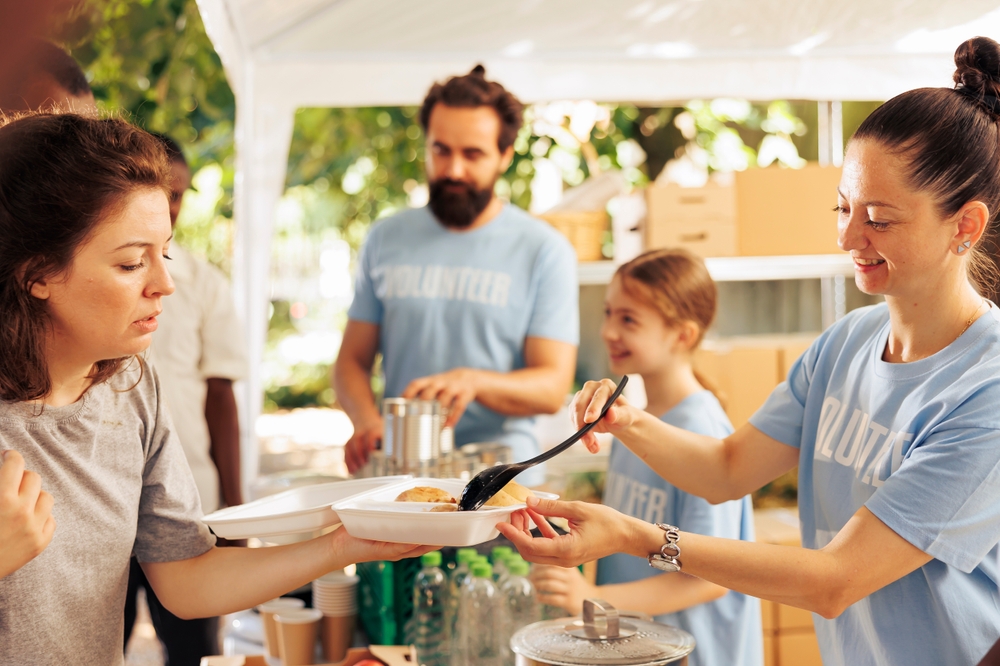11 Simple Ways to Practice Gratitude as a Family
Practicing gratitude as a family can strengthen bonds and foster a positive mindset. Whether through daily rituals or creative activities, expressing thanks helps everyone focus on the good things in life. From sharing kind words at mealtimes to volunteering together, there are many simple ways to nurture a sense of appreciation within the family. These practices not only promote gratitude but also create lasting memories and encourage a spirit of kindness and connection.
This post may contain affiliate links, which helps keep this content free. Please read our disclosure for more info.
Share Thanks at Mealtimes

Mealtime is more than just a time to eat; it’s an opportunity to come together as a family and reflect on the positives of the day. Before everyone starts eating, gather around the table and take a moment to share something you’re thankful for. This practice encourages everyone to pause and acknowledge the good things, big or small, that happened in their lives. Whether it’s a small victory, a special moment with a friend, or simply the food on the table, sharing these thoughts out loud strengthens family bonds and helps everyone focus on gratitude instead of stress or negativity.
In addition, this routine helps set a peaceful and positive tone for the rest of the meal and the evening. It encourages family members to actively listen to one another, creating a sense of connection. It’s a practice that can be easily adapted to fit any family schedule and helps to instill a habit of gratefulness. Sharing thanks at mealtimes also fosters a sense of unity, where everyone feels heard and appreciated, making it a simple yet effective way to practice gratitude consistently.
Create a Gratitude Jar

A gratitude jar can become a cherished tradition for families, offering a tangible and ongoing way to express thankfulness. Start by setting up a jar in a prominent spot in your home, along with small pieces of paper and pens. Encourage every family member to write down something they are grateful for whenever they feel inspired. It can be done daily or weekly, and the best part is that it’s flexible enough to suit any family’s routine. Over time, the jar fills up with notes that reflect moments of joy, kindness, or simple blessings that might otherwise go unnoticed.
At the end of the month, or even once a year, gather the family together to read through the notes in the gratitude jar. This activity not only allows for shared reflection but also highlights the positive moments that made up the year, reminding everyone of what really matters. It can spark conversation and remind family members of things they might have forgotten, further strengthening the family’s connection to each other. Plus, it’s a beautiful way to celebrate the little things and appreciate what may be easily overlooked in the rush of daily life.
Volunteer as a Family

Volunteering is a meaningful way for families to show gratitude by helping others in their community. By choosing a local cause or charity to support, family members can actively give back, which allows them to see how their actions can make a positive impact on others. Volunteering together creates shared experiences that are valuable not only for those receiving help but for the volunteers themselves. It can be something as simple as helping at a food bank, cleaning up a local park, or visiting a senior center. These acts of service create opportunities to reflect on the privileges and resources the family has and use that awareness to help those who are less fortunate.
Moreover, volunteering as a family reinforces the importance of empathy and kindness, teaching children valuable life lessons about community, selflessness, and gratitude. It strengthens the family’s emotional connection as they work together towards a common goal. The act of helping others also builds a sense of accomplishment and pride, knowing that their efforts are making a difference. For children, it can be an eye-opening experience, allowing them to see beyond their own world and recognize the importance of gratitude in both words and actions.
Make Thank You Cards

Making thank you cards together as a family is a creative and personal way to express gratitude. This simple activity can be done after receiving gifts, helping others, or just to show appreciation for someone’s kindness. Gather the family around a table with art supplies, and encourage everyone to design their own thank-you cards. Whether they are writing to a relative, a teacher, or a friend, the cards become a way to teach children the value of expressing appreciation. The process of making the cards is a reminder that gratitude is best expressed through thoughtful actions, and it helps reinforce the importance of showing thanks in meaningful ways.
This activity also serves as a bonding experience. Family members can share their thoughts on why they are thankful for someone and help one another come up with heartfelt messages. The act of creating a personal card shows that gratitude is not just something to feel but something to share with others. After the cards are made, you can send them out together as a family, making it a rewarding and heartwarming experience for everyone involved. It also teaches children the importance of acknowledging kindness and encourages them to recognize how their actions affect others.
Keep a Family Gratitude Journal

A family gratitude journal is a wonderful way to reflect on the good things that happen in life, both big and small. Each day or week, set aside time for everyone to write down or share something they are thankful for in the journal. This practice can include anything from a beautiful moment spent together to a personal achievement or even a special event in the community. Writing these thoughts down reinforces the habit of gratitude and creates a tangible record of the family’s blessings. It also provides an opportunity to look back on the journal and reflect on how much has been appreciated over time.
As a family, reviewing the journal at regular intervals is a meaningful way to revisit the positive moments from the past. This activity allows for reflection on the year’s growth and the things that made everyone happy. It also creates a space for family members to express gratitude for each other, further strengthening their bonds. A family gratitude journal encourages ongoing appreciation, and by sharing the experience, it reinforces the value of noticing and celebrating the good things in life.
Create a Gratitude Tree

A gratitude tree is a fun and interactive way to practice thankfulness as a family, especially during the fall or holiday seasons. You can start by drawing a tree on a large piece of paper or creating a simple tree structure out of branches placed in a vase. Provide family members with paper leaves or cut-out shapes where they can write down what they are grateful for. As the days go by, each person adds their “thankful” leaf to the tree, growing it into a colorful display of gratitude. This ongoing activity encourages everyone to reflect on what they appreciate, whether it’s a person, a memory, or something in nature.
The gratitude tree becomes more than just a visual reminder of the family’s thanks. It becomes a collaborative project that everyone looks forward to contributing to. As you add leaves to the tree, you can also use it as an opportunity to reflect on how much the family has grown and what they have shared. At the end of the season, it’s a beautiful keepsake of gratitude that shows how many things your family appreciates, turning it into a wonderful holiday or year-round tradition.
Practice Random Acts of Kindness

Encouraging random acts of kindness as a family is a great way to practice gratitude, not only for each other but for those outside the home. This could be anything from paying for someone’s coffee to helping a neighbor carry groceries or sending a note to someone who needs encouragement. By making kindness a habit, you help everyone recognize that gratitude can be shown through action. It also teaches family members that gratitude is not just about feeling thankful, but about making the world a little brighter for others.
This practice can also create memorable moments for the family as they share stories of their random acts of kindness. Whether it’s helping a stranger or doing something nice for a friend or family member, these experiences can be talked about and celebrated. It’s a reminder that small gestures often mean the most, and that gratitude can be extended beyond the family circle to touch the lives of others. Over time, this practice helps to foster a more compassionate and grateful family culture.
Share a Gratitude Story

Sharing a gratitude story is a simple yet powerful way to practice thankfulness as a family. Set aside time each week or month to gather and talk about a meaningful experience that someone is thankful for. It could be a family member recounting a special moment from their life, such as the time they overcame a challenge or the memory of an unforgettable trip. Encouraging storytelling allows everyone to reflect on their experiences and express their gratitude for people, moments, and lessons learned.
Not only does this activity foster communication, but it also helps create an environment where everyone feels comfortable sharing personal moments. Listening to each other’s stories strengthens emotional bonds and reminds everyone of the things they may sometimes take for granted. The practice of gratitude through storytelling helps family members not just appreciate what they have but also recognize the significance of the relationships and experiences that shape their lives.
Have a Family Thankfulness Parade

A thankfulness parade is a lively and joyful way to celebrate gratitude together. This activity is enjoyable for younger children, as it involves creating signs, costumes, or even musical instruments to represent what each family member is thankful for. Once everyone is ready, take a walk around the neighborhood or around your house, proudly displaying the things you are grateful for. This playful approach makes gratitude more engaging and helps children express their thanks in creative ways, turning a typical family tradition into an exciting and meaningful event.
This parade serves as a reminder that gratitude doesn’t have to be a somber activity; it can be full of joy and celebration. As family members walk or parade together, they can share why they chose certain things to represent their gratitude. The activity also fosters a sense of community, as neighbors or friends may take notice and be reminded of the importance of thankfulness. Whether inside or outside, the family’s thankfulness parade will leave everyone with warm memories and a sense of unity.
Practice Mindful Gratitude Meditation

Mindful gratitude meditation is a peaceful way to connect as a family and center your thoughts on thankfulness. Set aside time each day, perhaps in the morning or before bed, to practice a simple meditation together. Encourage family members to close their eyes, take deep breaths, and reflect on three things they are thankful for. It could be as simple as having a loving family, a warm home, or good health. The goal is to quiet the mind and focus on appreciation, allowing gratitude to wash over everyone.
This practice can be particularly calming for children who may have trouble winding down before bed. It helps them learn how to focus their thoughts on the positive and sets a peaceful tone for the evening. As a family, practicing mindfulness together not only deepens individual gratitude but also strengthens emotional connections. It’s an opportunity to bond over shared quiet moments and encourages the entire family to embrace a more mindful approach to gratitude.
Create a Thankfulness Wall

A thankfulness wall is an interactive and creative way to visually showcase gratitude in the home. Dedicate a section of a wall or bulletin board to thankfulness, where family members can pin or post notes about what they are grateful for. This could include small notes, pictures, or drawings representing different aspects of life they appreciate. Over time, the wall becomes a visual reminder of all the things the family holds dear and helps to reinforce the importance of focusing on the positive.
What makes the thankfulness wall especially effective is that it is always visible to the family. Whenever someone feels down or needs a reminder of their blessings, they can walk by the wall and reflect on what has been shared. It encourages an ongoing discussion about gratitude and allows family members to contribute to it at their own pace. This living wall of appreciation serves as a lasting testament to the positive things that have shaped the family’s experiences.
This article originally appeared on Avocadu.
